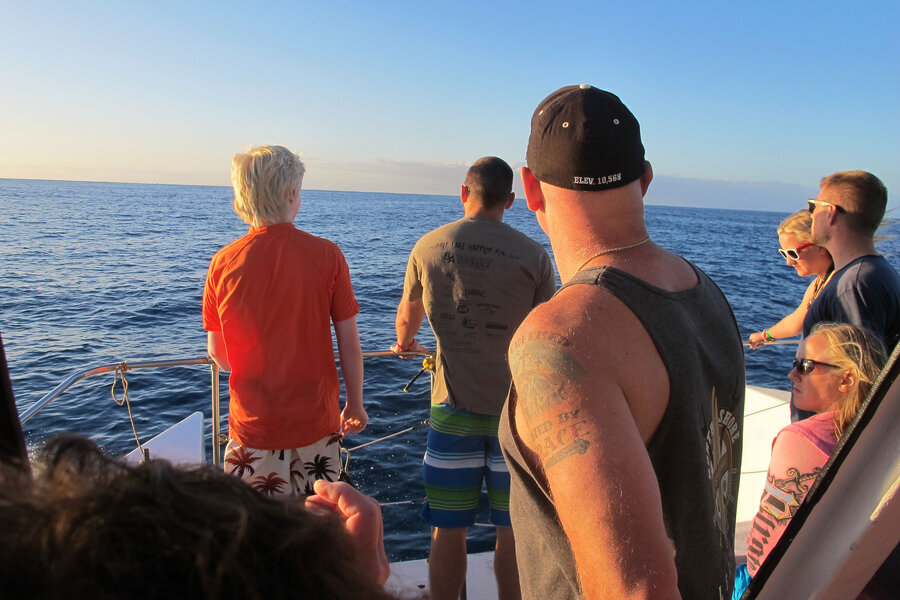Ban on swimming with dolphins in Hawaii? How animal ethics are changing
Loading...
Swimming with dolphins is one of the main attractions for many visitors to the Hawaiian islands, but federal officials are concerned that the close encounters – which provide jobs for many islanders – are harming the marine mammals.
The National Oceanic and Atmospheric Administration (NOAA) proposed a ban on close-up dolphin swims near Hawaii's coasts, a move to protect the delicate spinner dolphins that feed by night and sleep by day.
The spinner dolphins near Hawaii are "experiencing intense pressure" from tourists trying to swim or kayak in and around the dolphins' resting areas, said Ann Garrett, the Pacific Islands assistant regional administrator for NOAA Fisheries Office of Protected Resources.
"Peer-reviewed scientific literature documents disturbance of individual spinner dolphins as well as changes to spinner dolphin group behavioral patterns," NOAA's proposal states. "Individual dolphin responses to these activities vary, and in some cases may not be apparent to an observer (e.g., elevated heart rates or increased watchfulness)."
At a minimum, the proposed ban would permanently change dolphin encounter businesses. Many entrepreneurs fear it would end them altogether.
"It would be the end of legitimate dolphin swimming," Kevin Merrill, an owner of Dolphin Discoveries in Kona, Hawaii Island, told The New York Times. "We couldn't offer the people the quality interaction that they expect."
NOAA officials do not disagree, though they insist that other wildlife and whale-watching tours could go on.
The proposed rules would ban boats and swimmers within 50 yards of dolphins and could "eliminate all commercial activities that result in take of spinner dolphins (e.g., swim-with-wild-dolphins) at a close distance," officials wrote, resulting in "a reduction in revenue in the short term and potentially in the long term."
The balance is complex, but the current view of how humans should treat the animal kingdom likely falls toward NOAA's dolphin-protecting rules, says Mark Rowlands, a philosophy professor with a specialty in animal cognition at the University of Miami.
"The ethical question boils down to whether the commercial interests of humans should be allowed to outweigh the vital interests [in this case, rest] of dolphins," Dr. Rowland tells The Christian Science Monitor by email. "The fundamental precept of the animal rights movement is that commercial interests of humans should not be allowed to outweigh vital interests – even if those interests belong to nonhuman animals."
There are dozens of such tour companies, NOAA estimated, and almost all are small, family- or single-owner businesses, taking in less than $7.5 million each. Thirty-five different dolphin swim tour businesses exist, they estimate, in addition to a similar number of spiritual retreats that offer dolphin encounters. In addition, about 40 dolphin-watch tour boat companies operate, in addition to more general boat tour providers.
Mr. Merrill, who has given dolphin tours with his wife since 1992, told the Times that some unscrupulous tour operators had been moving too close, but he would rather see existing rules enforced before an outright ban destroyed the business.
"You don't swim with the dolphins," he said. "The dolphins choose to swim with us."
Officials counter that the boats and swimmers deliberately target the shallow areas where the spinners are resting and tending their young. These sea mammals are largely nocturnal, so many of these tours occur while the dolphins are resting after a night of active feeding.
According to one study, 83 percent of human-dolphin encounters took place in the "essential daytime habitats" where the dolphins sleep, "because encounters with dolphins in these areas are virtually guaranteed." Another study found more than a dozen tour boats jockeying for position around a single dolphin group, with more than 50 snorkelers in the water.
Dolphin swimming tours have changed since the advent of the selfie era, with tourists trying to get even closer for the perfect shot. Although harassment is already illegal, the NOAA worries that the dolphins are losing too much rest, which they say hurt their health and can drive down dolphin fertility.
"It's getting out of hand in a lot of areas where these animals are and they're a resource we have to protect. We have to be real responsible with them," Victor Lozano, the owner and president of Dolphin Excursions Hawaii, told Hawaii News Now.
These rules would harm the tour business, a tough blow for communities that are often promised tourism revenue as an incentive to support conservation. NOAA officials suggested a "SMART" approach to dolphin tours that maximizes the animals' protection without cutting tourists off entirely.
The proposed rules are part of a growing pro-animal movement that seeks to improve long-term treatment of animals.
The Baltimore National Aquarium, for example, announced a plan to retire its dolphins, at first just from performing and finally from aquarium life altogether, by 2020. Biologists are now taking the unprecedented step of building them a new sanctuary by the sea.
"There's no model anywhere, that we're aware of, for this," John Racanelli, the chief executive officer for the National Aquarium, told the Associated Press in June. "We're pioneering here, and we know it's neither the easiest nor the cheapest option."
On the other side of the country, SeaWorld finally announced the end of its capture and breeding program for orcas after intense public criticism, making the current generation of Shamu and friends the marine park's last.
The irony is that much of pro-animal enthusiasm, especially toward dolphins and whales, was inspired by the sort of up-close encounter environmentalists now seek to ban.
"We are proud of contributing to the evolving understanding of one of the world's largest marine mammals," SeaWorld CEO Joel Manby wrote in an op-ed for the Los Angeles Times. "Now we need to respond to the attitudinal change that we helped to create."








